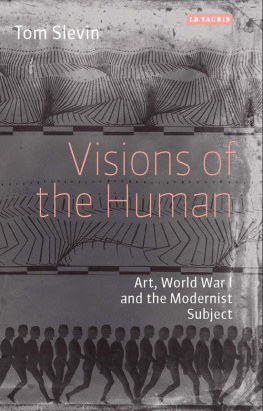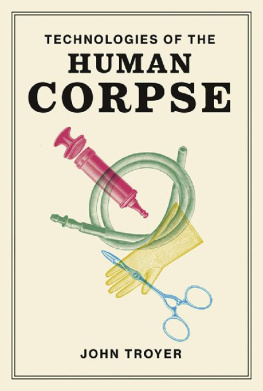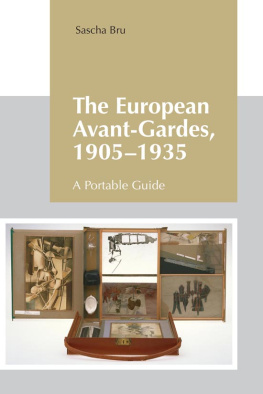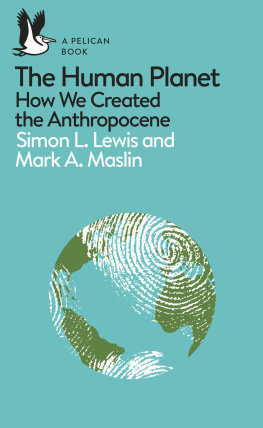Tom Slevin is Lecturer in Photography and Visual Arts atSouthampton Solent University.
Visions of the Human
Art, World War I and the Modernist Subject
Tom Slevin

First published in 2015 by I.B.Tauris & Co Ltd
www.ibtauris.com
Distributed worldwide by I.B.Tauris & Co Ltd
Registered office: 6 Salem Road, London W2 4BU
Copyright 2015 Tom Slevin
The right of Tom Slevin to be identified as the author of this work has been asserted by the author in accordance with the Copyright, Designs and Patents Act 1988.
All rights reserved. Except for brief quotations in a review, this book, or any part thereof, may not be reproduced, stored in or introduced into a retrieval system, or transmitted, in any form or by any means, electronic, mechanical, photocopying, recording or otherwise, without the prior written permission of the publisher.
Every attempt has been made to gain permission for the use of the images in this book. Any omissions will be rectified in future editions.
References to websites were correct at the time of writing.
International Library of Modern and Contemporary Art 22
ISBN: 978 1 78076 631 7
eISBN: 978 0 85773 891 2
A full CIP record for this book is available from the British Library
A full CIP record is available from the Library of Congress
Library of Congress Catalog Card Number: available
Typeset by Aptara
Contents
List of Figures
Acknowledgements
This book is the result of several years of research and study.However, it all began many years before as an undergraduate.The work is indebted to Chris Townsend for not only noticingsomething in my thinking and writing, but actively supportingand encouraging it. This book owes Chris a massive intellectualdebt, but also a very physical debt without him, these wordsand this book would not exist.
There are many people that I would like to thank for theiradvice and feedback over the course of this project. I am gratefulto Barry Langford for his support and comments. DeborahCherry, like Chris Townsend, helped sharpen my approach tocultural objects and also challenged my relation to academictheory. Peter Brooke provided generous and insightful commentson Albert Gleizes. Discussions with Barnaby Dicker were alwaysrefreshing and energetic. I could share difficulties and advice withElizabeth English and Austin Fisher. I am grateful to JuliaMoszkowicz for providing feedback on Chapter 1. Tim Armstrongand Neil Cox both gave great comments, and feedback on theproject. I would like to thank Body and Society for allowingme to publish an early research direction in their journal. Fashion Theory featured an edited version of Chapter 2 onSonia Delaunays simultaneous designs. Anne Quarles atRM Services was an excellent help in obtaining images andcopyrights.
I am grateful to Anna Coatman and Liza Thompson atI.B.Tauris for giving me the opportunity to publish my researchas a book and to Pat FitzGerald for her copyediting skills. Iwould also like to acknowledge Southampton Solent Universitywho provided funding for image copyrights. Alice Hogg at DACS replied to various copyright requests in a professional and timelymanner. I am grateful to others, too numerous to name here,who kindly helped clarify and resolve different permissionqueries.
Every effort has been made to contact copyright holders. Anyerrors or omissions brought to the attention of the publishers willbe made good in future editions.
An attempt has been made to keep reference to work in theiroriginal language where possible. English has been used for textsread and/or quoted in their translation, and at other times formatters of clarity. Similarly, both languages may be used wheremore familiar.
Projects such as this are almost impossible without thesupport and love of those closest to oneself. Thank you seems aninadequate sentiment for those qualities shown by my parents.Olive Richards and Margaret Harland passed away before thepublication of this book, but their kindness, generosity and loveare always present in my thoughts. Finally it is to Zoe and Emmythat I dedicate this book. Their patience and impatience has beeninstrumental to its development.
Introduction
The body is our general medium for having a world.
Maurice Merleau Ponty
The imagination of existence as a human being underwentan identifiable, radical transformation before, during,and after the Modern epoch. In 1913, the French writerCharles Pguy declared that the world has changed lesssince Jesus Christ than it has changed in the last thirtyyears.This book will consider the interrelation between artistic,scientific, technological, political, philosophic and socio-economicforces and relationships that shaped new ideas of the modernhuman subject .
The visual representation of the human body is a profoundlyimportant index for how human subjectivity, being andexistence have been historically understood within culture. Therepresentation of the body is a site for the dynamic relationbetween subjectivity and society. The body both generates thecapacity for subjective agency, in its embodiment, and is a sitefor its control. As John ONeil writes our bodies are thepermeable ground of all social behaviour, our bodies arethe very flesh of society human embodiment functions tocreate the most fundamental bond between the self and society.The bodys depiction, then, can never be neutral: it is burdenedwith the weight of cultural pressures from its inception. Howeverit is subsequently received, representation occurs in its specifichistorical moment, from a particular relation with a society inconstituting its culture. The image is a site, an artefact, uponwhich analysis can proceed from the imagination of the bodylocated at the convergence of interpenetrating and conflictingtensions, including those political, philosophic, socio-economic,technological, and scientific forces. The subject emerges atthis juncture through the image. It is precisely this view ofthe body, as an index of the historical relation betweenself and society, that helps us understand wider culturaltransformation.
Yet modern technological developments yielded new forms ofknowledge about the nature of reality and repositionedthe human body as the new object of knowledge. Newvisions of the human subject were created through atransformation of knowledge. The unfolding of technology,science and industrialisation within modernity yielded newknowledge about the nature of reality, revealing multiple,simultaneous fields of reality. Consider, for example, how WilhelmRntgens X-ray at the end of the nineteenth-century allowed forthe penetration of visible reality. Upon photographing hiswifes hand, Anna Bertha reportedly remarked: I have seenmy own death! She surely was referring to her skeletalrepresentation and its long symbolic relation to death, but wemight also reflect upon the perceived obsolescence of thehuman body and the failure, in this example, of embodiedperception to know and reveal the world. The perceptuallimits of the body were exposed and supplanted by newvisual technologies. This book will consider the affects oftechnological modernity and the imagination of a modern,human subject as it was represented by avant-garde artistsworking in Europe through different media, both old andnew.
The body has traditionally been neglected in Westernphilosophy, yet it is the founding principle upon which knowledge is based.during and after World War I. In its postwar production,the body became a rigid, yet vacant, site for ideologicalinscription. This new status was governed by a widespreadturn towards classicism, informed by tropes of integrityand cohesion, within an urgent narrative for stability andorder.













